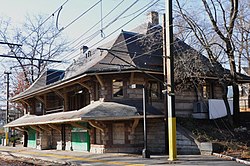Newton Railroad Stations Historic District
Newton Railroad Stations Historic District | |
 Newton Highlands station in 2011 | |
| Location | Newton, Massachusetts |
|---|---|
| Built | 1886–1891 |
| Architect | Henry Hobson Richardson; Shepley, Rutan & Coolidge |
| Architectural style | Richardsonian Romanesque |
| NRHP reference No. | 76002137[1] |
| Added to NRHP | March 25, 1976 |
The Newton Railroad Stations Historic District in Newton, Massachusetts is composed of three geographically separate historic railroad stations and one baggage/express building on the former Boston and Albany Railroad Highland branch, which was converted to MBTA Green Line D branch in 1959.
The four buildings in Newton are the only extant stations of thirteen designed by H.H. Richardson and his successors Shepley, Rutan, and Coolidge in Allston/Brighton, Newton, and Brookline for the Boston and Albany's Newton Circuit between 1881 and 1894.[2] Most originally had their grounds designed by landscape architect Frederick Law Olmsted, but none of the landscaping has survived.[3]
On March 25, 1976, the district was added to the National Register of Historic Places as the Woodland, Newton Highlands, and Newton Centre Railroad Stations, and Baggage and Express Building.
Structures[edit]
The District consists of four structures:[3]
- Woodland Railroad Station: Designed by Richardson (likely with significant input from Shepley, Rutan, and Coolidge); constructed in 1886. Now used for storage for an adjacent golf course; the modern station is some distance away.
- Newton Highlands Railroad Station: Designed by Shepley, Rutan, and Coolidge; constructed in 1887. Now houses a private business, with eaves providing shelter for the modern station.
- Newton Centre Railroad Station: Designed by Shepley, Rutan, and Coolidge; constructed in 1891. Now houses a restaurant, with eaves and canopy providing shelter for the modern station.
- Baggage and Express Building: constructed next to Newton Centre Railroad Station in 1891. Part of the structure has been demolished; the remaining portion has been integrated into a private business building.
See also[edit]
References[edit]
- ^ "National Register Information System". National Register of Historic Places. National Park Service. July 9, 2010. Retrieved February 4, 2016.
- ^ Ochsner, Jeffrey Karl (June 1988). "Architecture for the Boston & Albany Railroad: 1881–1894". Journal of the Society of Architectural Historians. 47 (2). doi:10.2307/990324. JSTOR 990324.
- ^ a b Roy, John H. Jr. (2007). A Field Guide to Southern New England Railroad Depots and Freight Houses. Branch Line Press. pp. 198–200, 261, 274. ISBN 9780942147087.
External links[edit]
![]() Media related to Newton Railroad Stations Historic District at Wikimedia Commons
Media related to Newton Railroad Stations Historic District at Wikimedia Commons
- National Register of Historic Places in Newton, Massachusetts
- Historic districts in Middlesex County, Massachusetts
- Railway stations on the National Register of Historic Places in Massachusetts
- Richardsonian Romanesque architecture in Massachusetts
- Historic districts on the National Register of Historic Places in Massachusetts

